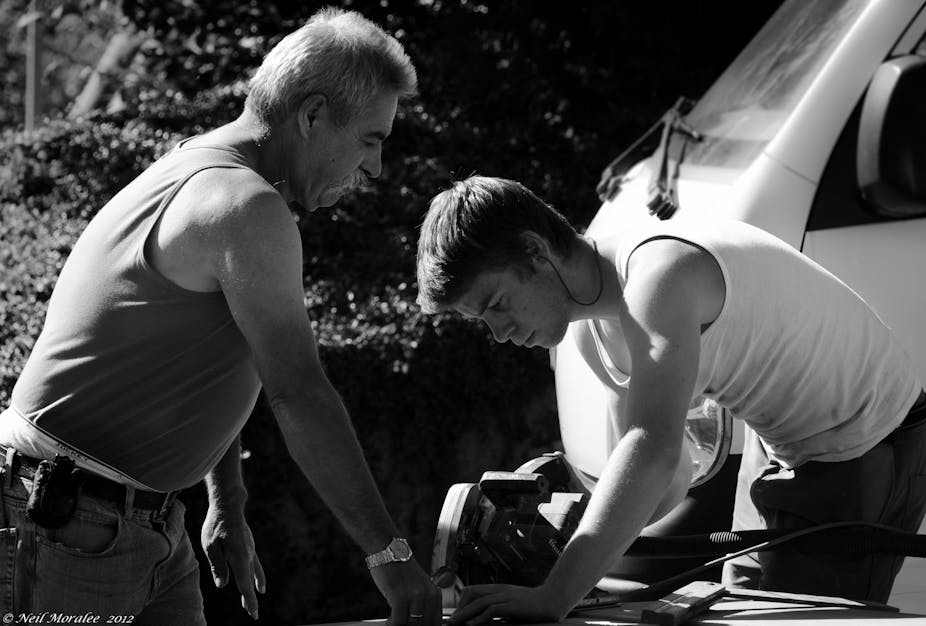There are many names for the narratives pitting the older generation against the younger: Gen-Y versus Baby Boomers, “Generation Me” versus “Generation We,” and unfortunately my research demonstrates that the younger generation do see the older generation as competitors.
My findings show overall that younger people have certain expectations of older workers and people, characterised by an overall desire for older adults to cede resources, get out of the way and make way for younger generations.
My studies also show that, fair or not, these expectations take three different forms. Young people expect that older adults actively make way for younger generations, such as by retiring. Young people also expect older adults to limit their usage of shared assets, such as health care. Finally, young people expect older adults to avoid engaging in the popular trends and activities that are the territory of the young.
Why we should care about these expectations
These intergenerational attitudes matter due to our rapid population ageing, the increased presence of multiple generations and the challenges that these trends present for businesses and for the economy.
Around the globe, the workforce is ageing. By 2055, 17.3% of the Australian workforce is estimated to be over 65; in the United States, older segments of the labour force are the only ones projected to grow substantially in the near future. The same types of trends can be seen in highly industrialised nations around the world, where up to five different generations co-exist in the modern workplace.
Complicating matters, the greying workforce has already presented significant challenges. In the US, the number of age discrimination charges has spiked by 47% since 1999; in Australia, a 2011 report found a 44% increase from the previous year in such complaints. Tellingly, surveys find that organisations are largely unprepared to accommodate the ageing workforce.
In addition, ageism is more socially condoned than other forms of discrimination. It does not have a historic, visible civil rights movement behind it, leading many to accept negative age-based attitudes (or ageing-related jokes, or older worker layoffs) as simply a fact of life.
Research findings
My research has sought to capture these phenomena via large-scale surveys and controlled behavioural experiments. In multiple studies, I manipulated the age of a male work partner (older, middle-aged, or younger), and found that older work partners were most resented by younger people for withholding or using up resources.
However, not all hope is lost. That same set of studies found that older male allies were particularly likeable. Older partners who were perceived as helping younger generations were rated more positively than middle-aged or younger partners doing the same thing. (Ongoing work explores whether the same expectations target older women.)
Moreover, a different set of studies found that portraying an abundance of resources between generations helped reduce these intergenerational tensions. This suggests that de-emphasising broad generational competition impacts their face-to-face interactions. With hope, older generations can been seen positively in the eyes of the young, so long as they come off as not getting in the way, as default perceptions seem to claim.

Recommendations for an ageing workforce
In order to successfully combat ageism and intergenerational tension, generations need to start seeing one another as assets and allies.
At the broad level, minimising the generational warfare narrative is an important first step. Not only are such accounts nonconstructive for an ageing, intergenerational society, but they also are not necessarily true.
Recent studies conducted in the United States and the European Union both find that older and younger generations are not in competition with one another for jobs — and that, if anything, the opposite is true.
At the local level, intergenerational partnerships can work only if they are seen as symbiotic. Portraying older generations as allies to the younger generation is one side of the equation.
On the older side, studies show that if older people ponder their enduring legacy, it can make them more sympathetic to reducing the burden on younger generations.
An important first step toward intergenerational productivity in the workplace is putting older employees in the best position to succeed. Surprisingly few organisations have adapted to accommodate older workers, but those that have done so enjoy various bottom-line benefits.
Above all, it benefits everyone to take stock of the issue, as it is not going away anytime soon. Fortunately, Australia has been proactive in taking policy action, evidenced by the recent establishment of an Age Discrimination Commission.
Research should help identify best practices, too. My research team at New York University, the AGE (Accommodating Generations in Employment) Initiative, studies how organisations can best exploit the increasingly ageing and intergenerational workforce.
In the same vein, at the University of Melbourne, the Centre for Workplace Leadership’s Ageing Workforce Initiative, with support from the Hallmark Ageing Research Initiative, is uncovering challenges associated with an ageing Australian workforce.
Nevertheless, considerably little attention exists on how to address these timely problems. This is the direction in which businesses, scholarship, and the public discussion must focus if we expect less intergenerational tension in the future.

